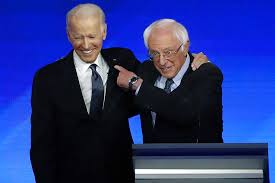 This article was written for L’Anticapitaliste, the weekly newspaper of the New Anticapitalist Party (NPA) of France.
This article was written for L’Anticapitaliste, the weekly newspaper of the New Anticapitalist Party (NPA) of France.
The Democratic Socialist of America (DSA), which now claims 70,000 members, will go into the November 2020 national presidential election endorsing no candidate. The last DSA Convention voted if Bernie Sanders was not the nominee, it would endorse no one. The motion, however does not stop DSA members as individuals from working for or voting for Biden, and some will work for him while many can be expected to vote for him, despite the fact that virtually no DSA members actually support him politically.
For the far left, socialists, anarchists, and anti-capitalists—who make up less than one percent of the population—Biden is problematic. The far left joined the progressives in supporting Senator Bernie Sanders, a liberal in the New Deal mold who ran as a “socialist” against the “billionaire class.” But since Sanders dropped out of the race and endorsed Biden, many on the far left have felt they have no candidate.
Biden is aptly characterized as a neoliberal. As a legislator Biden supported Bill Clinton’s reactionary and racist policies reducing social welfare and creating new criminal codes that increased imprisonment of Blacks and Latinx. He also faces an allegation of sexual assault, though it has not much affected his support.
Some say Biden is now moving to the left, and they give two reasons. First, Biden and Sanders created a Unity Task Force that has written a political program, which is at least rhetorically to the left of Biden’s historic positions. Second, the coronavirus crisis and the accompanying economic crisis may force Biden if elected president to adopt large-scale government economic interventions. Yet the Democratic Party platform has seldom had a significant influence on presidents once they are elected. Nevertheless, most people in the broad left will vote for Biden in November.
Outside of DSA are those who support the Green Party, a left party whose candidates for president and vice-president are Howie Hawkins, a retired truck driver, and Angela Walker, working class activist. The Green Party candidate Ralph Nader was the party’s highest vote getter with 2.7 percent of the vote in 2000, when he was accused of having cost former vice-president Al Gore the presidency by taking votes from the Democrats. In the November election, some will vote for Greens in “safe states” where the Democrats are sure to win, but many will be reluctant to vote for the Green Party in contested states. DSA members are mostly uninterested in the Green Party, which they see as irrelevant and ineffective.
All of this is part of a bigger debate within DSA about the Democratic Party. Historically, from the 1980s to the 2010s, DSA generally supported the Democratic Party nominee. DSA founder and political leader, Michael Harrington, believed the labor unions and the black movement could take over and “realign” the Democratic Party turning it into a socialist party. A new generation of DSA members in their 20s and 30s supported Bernie Sanders, but opposed the Democratic Party as a whole. The dominant view within DSA is that it is possible for DSA to use the Democratic Party ballot line to run socialist candidates or support other progressive candidates, looking forward to a future when DSA would break away and form a socialist party. A minority wants to create a socialist party now and some of the old guard prefer to focus on making the Democrats a more progressive party.
At the moment, with Sanders out of the race and with Biden the candidate, the debate about the future of the Democratic Party seems abstract. Fundamentally pragmatic, most DSA members will quietly vote for Biden, work to reelect Congresswoman Alexandria Ocasio Cortez and other socialist or progressive candidates, and continue their work in the social movements. The question of building a socialist party is postponed. Others on the left will vote Green or, ignoring the election, work on the movements.


Dan slightly misrepresents the old realignment strategy as “codified” by the Democratic Socialist Organizing Committee (DSOC, one of DSA’s predecessor organizations). The DSOC strategy was to build up a left opposition in the Democratic Party, with DSOC members in alliance with left-liberals (both activists and elected officials) and the most progressive unions, defined usually as the ones with the most anti-Cold War/pro-social democratic reform leaderships. Sometimes this meant supporting oppositions to entrenched labor tops, as in the Steelworkers (DSOC Steelworkers worked for Ed Sadlowski). The point was to marginalize the Democratic Party “regulars,” its business-funded candidates, and turn the DP into the equivalent of a soc-dem/labor party, with DSOC as its overtly anti-capitalist left wing. Of course, this didn’t happen. But DSOC/DSA never thought that the DP was going to become a *socialist* (anti-capitalist) party without a soc-dem “stage” if you will.
There were various problems with this strategy from the get-go, which I discuss here:
https://socialistforum.dsausa.org/issues/spring-summer-2019/what-would-bernie-do-a-possible-road-for-independent-political-action/
A detailed history of how sincere left-liberals, social democrats and socialists were defeated “within” the DP can be found here (note: most union tops didn’t help):
https://socialistregister.com/index.php/srv/article/view/28587/21119